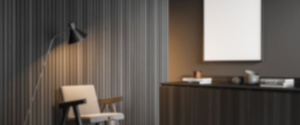Which Woods Should Be Used for Wood Wall Paneling?Which Woods Should Be Used for Wood Wall Paneling?

Which Woods Should Be Used for Wood Wall Paneling?
Wood wall paneling has become a popular interior design trend, with homeowners and designers alike seeking the perfect materials to add style, texture, and warmth to their spaces. Choosing the right wood for your wall paneling is essential for achieving the desired look and durability. When selecting the right
for your project, consider factors such as durability and aesthetic appeal. In this guide, we’ll explore the most popular woods used for wall paneling and why they are ideal for various applications.
MDF Wood Paneling
Medium-Density Fiberboard (MDF) is one of the most common choices for wood wall paneling in modern interior design. It offers versatility, affordability, and ease of installation, making it a go-to material for many DIY enthusiasts and professionals.
Benefits of MDF for Wood Wall Paneling
- Cost-Effective: MDF is significantly cheaper than natural wood, making it a budget-friendly option for wood wall paneling.
- Smooth Finish: The uniform texture of MDF makes it perfect for painting and finishing, offering a sleek, smooth appearance.
- Easy to Install: MDF is easy to cut, shape, and install, which simplifies the process for DIYers and professionals alike.
Drawbacks of MDF
- Moisture Sensitivity: MDF is not water-resistant, so it’s not suitable for areas with high humidity or potential exposure to moisture, like bathrooms or kitchens.
- Durability: Although MDF is sturdy, it doesn’t hold up as well as solid wood over time, especially in high-traffic areas.
Plywood for Wood Wall Paneling
Plywood is another popular choice for wood wall paneling, particularly in spaces where a natural wood grain appearance is desired. Plywood is made by layering thin sheets of wood veneer, which gives it strength and stability.
Benefits of Plywood for Wood Wall Paneling
- Natural Look: Plywood has a beautiful, natural wood grain that adds warmth and character to a space.
- Durability: Plywood is more durable than MDF and can withstand more wear and tear, making it ideal for high-traffic areas.
- Versatile: Plywood can be stained, painted, or finished in a variety of ways to suit different design preferences.
Drawbacks of Plywood
- Cost: Plywood is more expensive than MDF, which might be a consideration for those on a tighter budget.
- Potential for Warping: Plywood can warp if exposed to moisture, so it’s important to ensure proper sealing and treatment if used in humid environments.
Solid Wood Paneling
For those seeking a timeless and premium look, solid wood paneling is an excellent option. While it can be more expensive than other materials, the durability and aesthetic appeal of solid wood make it a worthwhile investment.
Benefits of Solid Wood Paneling
- Aesthetic Appeal: Nothing beats the rich texture and natural beauty of solid wood. It adds warmth, depth, and character to any room.
- Longevity: Solid wood is incredibly durable and can last for decades if properly cared for.
- Eco-Friendly: Many solid wood options come from sustainable sources, making it an environmentally friendly choice.
Drawbacks of Solid Wood
- Cost: Solid wood is the most expensive option for wood wall paneling, which may not fit into all budgets.
- Maintenance: Wood requires regular maintenance, such as refinishing or treating to prevent damage from moisture and wear.
Veneer Wood Paneling
Wood veneer is a thin layer of real wood that is applied to a core material, such as MDF or plywood. It offers the aesthetic of solid wood at a more affordable price point.
Benefits of Veneer Wood Paneling
- Authentic Look: Since veneer is made from real wood, it offers the same visual appeal as solid wood without the high cost.
- Cost-Effective: Veneer wood paneling is generally more affordable than using solid wood, making it a budget-friendly choice for those seeking a premium look.
- Lightweight: Veneer paneling is lighter than solid wood, which can make installation easier and less labor-intensive.
Drawbacks of Veneer
- Susceptibility to Damage: Veneer can be more easily damaged by scratches or dents, especially if the underlying material is not as durable.
- Limited Refinish Options: Unlike solid wood, veneer cannot be sanded down and refinished multiple times, so once it’s damaged, it may need to be replaced.
Reclaimed Wood Paneling
For an eco-friendly and rustic aesthetic, **reclaimed wood paneling is a fantastic choice. It involves repurposing old wood from buildings, barns, or other structures, giving it new life in modern interiors.
Benefits of Reclaimed Wood Paneling
- Sustainability: Using reclaimed wood reduces the demand for new lumber and minimizes environmental impact.
- Unique Aesthetic: Each piece of reclaimed wood has its own history and character, adding a unique touch to any space.
- Durability: Many reclaimed woods are from older trees, which tend to be denser and more durable than new-growth wood.
Drawbacks of Reclaimed Wood
- Cost: Reclaimed wood can be expensive due to the process of sourcing and preparing the wood for use.
- Inconsistent Quality: Since reclaimed wood comes from various sources, it may have inconsistencies in texture, color, or durability.
Making the Right Choice for Your Wall Paneling
Many homeowners opt for
due to its affordability and versatility in design. Choosing the right wood for your wood wall paneling depends on several factors, including your budget, design preferences, and the specific requirements of your space. MDF is ideal for those seeking a cost-effective and easy-to-install option, while plywood and veneer offer a natural wood look at a lower cost than solid wood. For a high-end, timeless appeal, solid wood or reclaimed wood paneling may be the best choice.
Different types of
can dramatically alter the look and feel of your space. No matter which material you choose, proper installation and maintenance are key to ensuring your wood wall paneling looks great and lasts for years to come.


